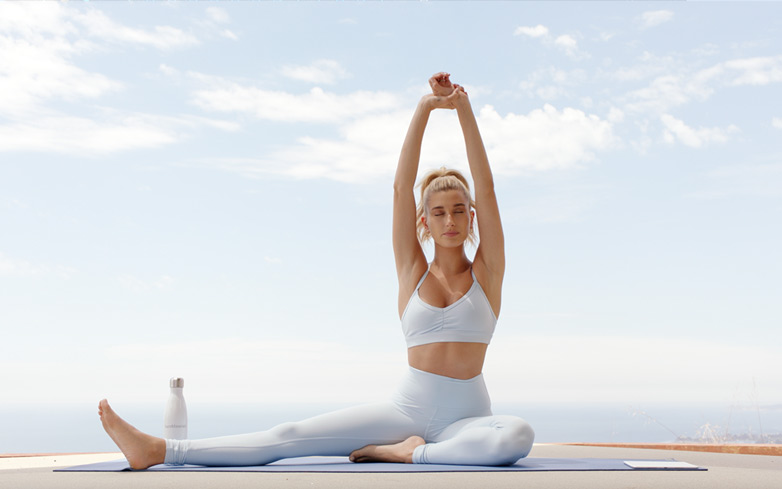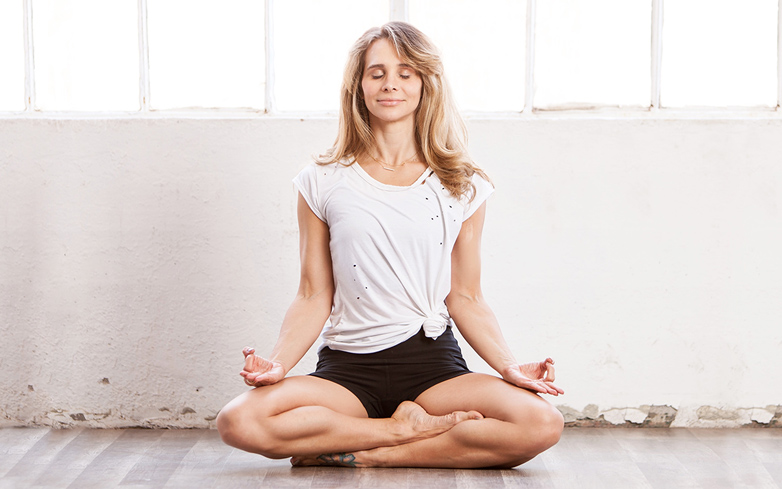How to Stick With Yoga, Even When Life Gets in The Way

When life is trucking along in business-as-usual mode, there are moments when your sleep schedule, diet, and dedication to a yoga studio and practice align in a magnificent way. You feel so good you can truly embrace moderation and everything feels wonderful and balanced. And then…
Life sits squarely in that aforementioned business-as-usual sweet spot all too rarely. When work travel, a destination wedding, a pregnant yoga instructor, or, say, a global pandemic intervenes, it all falls apart. What is often labeled so virtuously as “discipline,” might very well be better characterized as inertia. But just because you’re momentarily derailed doesn’t mean all is lost.
It Doesn’t Have to Be All or Nothing
Human nature has us wanting to organize our surroundings. Routine acts as an important touchstone, and helps us create and stick to good habits without having to reinvent the wheel, day after day. Yoga devotees in particular are quite committed to their studios, instructors and methods — and there’s great value in this. We find community, gain mastery and create routines we adhere to.
What’s less adaptive, says yoga instructor and wellness counselor Kiley Holliday, is allowing the entire machine to fail when one piece gets knocked out of place. Instead, Kiley guides her clients to take the best possible advantage of time away. She doesn’t see this as cannibalizing her own business, but rather as a way to keep clients engaged, injury-free, and growing as yogis. Even with routines that serve us well, we can lose our motivation, suffer injuries based on repetitive motion, and leave other muscles and joints underworked, creating imbalances that we’ll likely pay for later.
Here are small ways you can bridge forced interruptions — or even create them yourself — in the interest of broadening your repertoire, driving the yoga ball forward, and investing in the (injury-free) long game.
Yoga Cross-Training
So you’ve spent all this time working up to an enviable forearm stand. Saying you have a “yoga body” wouldn’t be entirely out of line. You work to stay grateful and mindful, and you understand that you didn’t really know how to breathe until yoga came into your life. And this is all amazing! But there are myriad reasons and infinite ways to inject some needed variety into your program.
- Trade the studio for a virtual class, and vice versa. Peer pressure can force you to hold that difficult posture for that extra bit, and privacy allows you to try (and maybe fail at) something new without penalty.
- Try a new style entirely. It’s hard to try new things as an adult, and even harder to be bad at them. But when we’re feeling uneasy in a novel environment, we respond with increased effort and fire on all cylinders. Neural pathways strengthen and previously under-tapped muscles, ligaments, and tendons are called into play. And instead of feeling bored or complacent when you get back to your favorite class, you feel like an all-star.
- Take it down a notch. The importance of consistent rest and recovery can’t be overstated. Squeeze in some restorative yoga or even just stretch on your hotel room bed before you turn in for the night. Even professional athletes incorporate scheduled down time within their training programs for healing and muscle repair.
- Work new elements into your practice — music, for one. Take a class at a music-centered studio, or download soundtracks curated specifically for yoga and conscious movement. Kiley herself is a fan. “I love practicing with music. Some people think it’s a distraction, but to me, music is a way to bring joy into the practice.”
- Get out there — try something that’s way off your beaten path. Aerial yoga. Goat. Nude. If you can think of it, it probably exists somewhere. If you’ve gotten too caught up in the performative aspect of yoga in the studio or on Instagram, maybe it’s time to take it (or yourself) less seriously for a spell.
- Time shift your regimen. There’s much to be said for working within your natural body rhythms, but it’s worth experimenting anyway. Wait until life is a disruptor — then run with it. Even for the early bird, the sensation of your weary head hitting the pillow after an evening Bikram class can be pretty great. And for the night owl, knowing your yoga is behind you before heading to work offers a refreshing sense of morning accomplishment. This isn’t a lifetime commitment, but rather a way to accommodate scheduling changes and shock your body with something different.
Yoga on-the-Fly
Kiley doesn’t suggest that you halt drink service for half the aircraft in the name of performing a mile-high triangle pose in the aisle. But that doesn’t mean that you can’t integrate yoga into your travels — and your errands, commute, workday and more.
- Remember first, that yoga isn’t limited to just the physical practice. “I think of yoga as a philosophical prescription for living,” says Kiley. “Your yoga practice can involve asana [poses], but really the definition of yoga is the cessation of the whirlings of the mind.” Nowhere does the mind get whirling much more than on jetlag-rich, stress-riddled business trips. Kiley herself isn’t a great flier “ironically,” she laughs, and uses breathwork to get herself though. If you’re lucky enough to be a great traveler, you can even better take advantage of that downtime, working on using your breath to regulate your thoughts, heartrate and emotions.
- Meditation, right next to breathwork, is another form of yoga that’s easy to maintain through travel, deadlines, social obligations, and other impediments to your usual routine. Meditation techniques abound and are a matter of personal preference, although Kiley says that to a certain extent, “they’re different methods of getting to the same place.” The mind has a tendency to wander, “so you give it direction.” Even the least meditative among us can benefit from a first-thing-in-the-morning or last-thing-at-night body scan — described as a “guided tour of the body enabling you to slowly focus and be still.”
- Remember too, that our practice is cumulative — it doesn’t have to be 90 minutes in a row. Or even ten. Maybe you can manage a mindful walk to work, some seated twists at your desk, or to read about yoga techniques or yogic philosophy while waiting for an appointment. Meditate your way through traffic in a taxi, do finger and wrist stretching and strengthening movements watching TV, practice balancing exercises while brushing your teeth or preparing for a presentation. All of this works to further your practice in ways that a routine consisting exclusively of fancy-pose, high-intensity classes won’t.
So, say thank you to life’s little twists, turns, interruptions, annoyances, and unexpected obligations, for giving you that gentle push towards a more well-rounded routine, incorporating yoga in all its varied glory.






